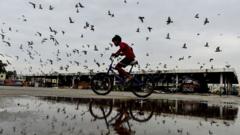In Mumbai, a recent court-imposed ban on pigeon feeding has ignited a major conflict involving civic authorities, health advocates, and cultural enthusiasts. The ban, intended to mitigate health hazards from pigeon droppings, has led to significant protests, including confrontations with law enforcement.
Civic bodies cite escalating respiratory health issues attributed to pigeon droppings as the driving force behind this legislation. Protests erupted after the closure of traditional feeding sites, or kabutarkhanas, where locals have long gathered to nourish these birds.
Mumbai is not alone in this dilemma; other major cities, including Delhi, Thane, and Pune, have implemented or considered similar restrictions. The feeding of pigeons has been outlawed in other global cities such as Venice and New York City, highlighting a broader trend of managing urban wildlife.
Cultural implications are profound in Mumbai, particularly among the Jain community, for whom feeding pigeons is a spiritual practice. Many feel intertwined with these birds—seen as symbols of peace— and express concern that needs for tradition and faith are being marginally overlooked.
As pigeon populations surge—reported to have increased over 150% in India since 2000—experts warn of severe public health risks. Pigeon droppings can harbor pathogens leading to serious diseases like pneumonia and hypersensitivity pneumonitis, prompting a re-evaluation of urban bird management practices.
Local resident Nirmal Kohli's recent health decline, allegedly linked to prolonged exposure to pigeon feces, has fueled the health discourse surrounding the ban. Despite concerns, several animal rights advocates push back, emphasizing the need for coexistence and suggesting regulated feeding hours to maintain cleanliness while allowing people to connect with pigeons.
In the wake of public pushback, some Mumbai officials have indicated a willingness to find a compromise. An expert panel has been assembled to explore alternative solutions that balance public health with cultural heritage, indicating potential for reimagined community practices around urban wildlife.
As discussions continue, community members express hope for a respectful coexistence that acknowledges both health considerations and the emotional ties many have to the city's pigeons.
Civic bodies cite escalating respiratory health issues attributed to pigeon droppings as the driving force behind this legislation. Protests erupted after the closure of traditional feeding sites, or kabutarkhanas, where locals have long gathered to nourish these birds.
Mumbai is not alone in this dilemma; other major cities, including Delhi, Thane, and Pune, have implemented or considered similar restrictions. The feeding of pigeons has been outlawed in other global cities such as Venice and New York City, highlighting a broader trend of managing urban wildlife.
Cultural implications are profound in Mumbai, particularly among the Jain community, for whom feeding pigeons is a spiritual practice. Many feel intertwined with these birds—seen as symbols of peace— and express concern that needs for tradition and faith are being marginally overlooked.
As pigeon populations surge—reported to have increased over 150% in India since 2000—experts warn of severe public health risks. Pigeon droppings can harbor pathogens leading to serious diseases like pneumonia and hypersensitivity pneumonitis, prompting a re-evaluation of urban bird management practices.
Local resident Nirmal Kohli's recent health decline, allegedly linked to prolonged exposure to pigeon feces, has fueled the health discourse surrounding the ban. Despite concerns, several animal rights advocates push back, emphasizing the need for coexistence and suggesting regulated feeding hours to maintain cleanliness while allowing people to connect with pigeons.
In the wake of public pushback, some Mumbai officials have indicated a willingness to find a compromise. An expert panel has been assembled to explore alternative solutions that balance public health with cultural heritage, indicating potential for reimagined community practices around urban wildlife.
As discussions continue, community members express hope for a respectful coexistence that acknowledges both health considerations and the emotional ties many have to the city's pigeons.



















